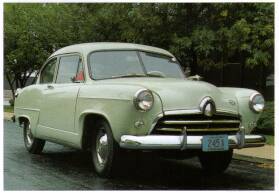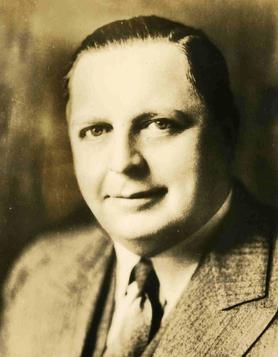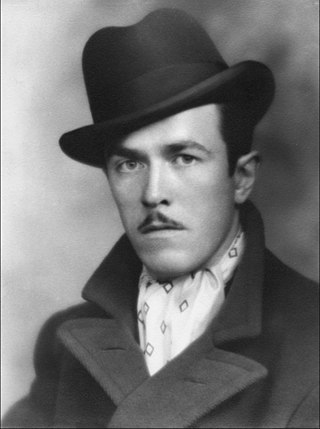Related Research Articles


Studebaker was an American wagon and automobile manufacturer based in South Bend, Indiana, with a building at 1600 Broadway, Times Square, Midtown Manhattan, New York City. Founded in 1852 and incorporated in 1868 as the Studebaker Brothers Manufacturing Company, the firm was originally a coachbuilder, manufacturing wagons, buggies, carriages and harnesses.

Kaiser Motors Corporation made automobiles at Willow Run, Michigan, United States, from 1945 to 1953. In 1953, Kaiser merged with Willys-Overland to form Willys Motors Incorporated, moving its production operations to the Willys plant at Toledo, Ohio where they continued to build automobiles under the Kaiser marque including the Kaiser Darrin until 1955. Their South American operations continued to build passenger cars well up into the 1960s. The company changed its name to Kaiser Jeep Corporation in 1963.

The Hudson Motor Car Company made Hudson and other branded automobiles in Detroit, Michigan, U.S., from 1909 until 1954. In 1954, Hudson merged with Nash-Kelvinator to form American Motors Corporation (AMC). The Hudson name was continued through the 1957 model year, after which it was discontinued.
Virgil Max "Ex" Exner Sr. was an automobile designer for several American automobile companies, most notably Chrysler and Studebaker.

Clifford Brooks Stevens was an American industrial designer of home furnishings, appliances, automobiles, and motorcycles, as well as a graphic designer and stylist. Stevens founded Brooks Stevens, Inc., headquartered in Allenton, Wisconsin.

The Ford Piquette Avenue Plant is a former factory located within the Milwaukee Junction area of Detroit, Michigan, in the United States. Built in 1904, it was the second center of automobile production for the Ford Motor Company, after the Ford Mack Avenue Plant. At the Piquette Avenue Plant, the company created and first produced the Ford Model T, the car credited with initiating the mass use of automobiles in the United States. Prior to the Model T, several other car models were assembled at the factory. Early experiments using a moving assembly line to make cars were also conducted there. It was also the first factory where more than 100 cars were assembled in one day. While it was headquartered at the Piquette Avenue Plant, Ford Motor Company became the biggest U.S.-based automaker, and it would remain so until the mid-1920s. The factory was used by the company until 1910, when its car production activity was relocated to the new, bigger Highland Park Ford Plant.
The Studebaker-Packard Corporation was the entity created in 1954 by the purchase of the Studebaker Corporation of South Bend, Indiana, by the Packard Motor Car Company of Detroit, Michigan. While Studebaker was the larger of the two companies, Packard's balance sheet and executive team were stronger than that of the South Bend company.

The Packard Clipper is an automobile that was built by the Packard Motor Car Company for model years 1941–1942, 1946–1947 and 1953–1957. For 1956 only, Clipper was classified as a stand-alone marque. The Clipper was introduced in April 1941, as a mid-model year entry. It was available only as a four-door sedan. The Clipper name was re-introduced in 1953, for the automaker's lowest-priced lineup. By 1955, the Clipper models were seen as diluting Packard's marketing as a luxury automobile marque. It was named for a type of sailing ship, called a clipper.

Richard Arthur Teague was an American industrial designer in the North American automotive industry. He held automotive design positions at General Motors, Packard, and Chrysler before becoming Vice President of Design for American Motors Corporation (AMC), and designed several notable show cars and production vehicles including AMC's Pacer, Gremlin, and Hornet models, as well as the Jeep Cherokee XJ and either designed or assisted in the designing of later cars for Chrysler such as the Jeep Grand Cherokee and Neon after American Motors' buyout.

George Walter Mason was an American industrialist. During his career Mason served as the Chairman and CEO of the Kelvinator Corporation (1928-1937), Chairman and CEO of the Nash-Kelvinator Corporation (1937-1954), and Chairman and CEO of American Motors Corporation (1954).
Dietrich Inc. was an American coachbuilder founded in 1925 by Raymond H. Dietrich (1894–1980), co-founder of LeBaron Incorporated in New York City. He was a close friend to Edsel Ford who supported him by talking the owner of the J W Murray Manufacturing Co into partly financing the venture. Murray was itself a vendor of standard bodies to the Ford Motor Company, and hoped for an in-house source for designing and building custom bodies for luxury cars. Dietrich himself held 50% of the stock.

The Packard Proving Grounds, was a proving ground established in Shelby Charter Township, Michigan in 1927 by the Packard Motor Car Company of Detroit. It is listed in the National Register of Historic Places.

The Kaiser Darrin, also known as the Kaiser Darrin 161 or in short as the Darrin, was an American sports car designed by Howard "Dutch" Darrin and built by Kaiser Motors for the 1954 model year. Essentially a revamp of Kaiser's Henry J compact, the Kaiser Darrin was one of its designer's final achievements and was noted for being the second American car equipped with a fiberglass body and doors that slid on tracks into the front fender wells. The car was named both for Henry J. Kaiser, head of Kaiser Motors, and Darrin.

The Piquette Avenue Industrial Historic District is a historic district located along Piquette Street in Detroit, Michigan, from Woodward Avenue on the west to Hastings Street on the east. The district extends approximately one block south of Piquette to Harper, and one block north to the Grand Trunk Western Railroad Line. It was listed on the National Register of Historic Places in 2004.

Richard Henry Arbib was an American industrial designer.

Theodore Wells Pietsch II was an American automobile stylist and industrial designer who, with little formal education, managed to launch a career in automobile design that took him over a period of 38 years to nearly every major automobile company in the nation.

Owen Ray Skelton was an American automotive industry engineer and automobile designer. Along with Fred M. Zeder and Carl Breer, he was one of the core group who formed the present day Chrysler Corporation. He made material contributions to Tourist Automobile Company, Allis-Chalmers, Studebaker, and was the main engineer behind the Chrysler Airflow automobile. He was elected to the Automotive Hall of Fame in 2002.

The Three Musketeers is a nickname given to a team of three Studebaker engineers, Frederick Morrell Zeder, Owen Ray Skelton, and Carl Breer. They would become instrumental in the founding of the Chrysler Corporation, and were hand-picked by Walter Chrysler to come with him when he started the new company.
Briggs Manufacturing was an American, Detroit-based manufacturer of automobile bodies for Ford Motor Company, Chrysler Corporation and other U.S. and European automobile manufacturers.
References
- ↑ Adamson, Glenn; Museum, Milwaukee Art (2003). Industrial strength design: how Brooks Stevens shaped your world. Milwaukee Art Museum. p. 115. ISBN 9780262012072 . Retrieved 25 July 2014.
- ↑ Ward, James Arthur (1995). The Fall of the Packard Motor Car Company. Stanford University Press. pp. 254–. ISBN 9780804724579 . Retrieved 25 July 2014.
- Automobile Quarterly, Volume XII, No 3 - 1974.